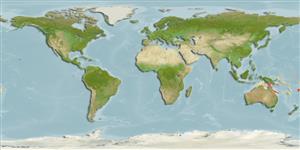>
Gobiiformes (Gobies) >
Schindleriidae (Infantfishes)
Etymology: Schindleria: Named for ichthyologist Otto Schindler, 1906-1959 (Prof. Dr. Konrad Schindler, pers. comm Dec. 2017).; brevipinguis: From the small size of the species ('brevi') and the deeper, broader ('pinguis' = stout) body..
Environment: milieu / climate zone / depth range / distribution range
Écologie
marin récifal; profondeur 15 - 30 m (Ref. 52019). Subtropical
Western Pacific: Australia.
Length at first maturity / Taille / Poids / Âge
Maturity: Lm 0.7, range 1 - 0.8 cm
Max length : 0.8 cm SL (female)
Description synthétique
Morphologie | Morphométrie
Rayons mous dorsaux (Total): 13; Rayons mous anaux: 10 - 11; Vertèbres: 35 - 36. Body small, stout, unpigmented. Body depth at pectoral-fin origin 9-12% of standard length and at anal-fin origin 9-14% SL. First dorsal-fin ray at myomere 18-20 and first anal-fin ray below dorsal-fin ray 4. Vertebrae 20 + 15-16 = 35-36, myomeres 19-20 + 14-16 = 34-36. Premaxillae and dentaries lack teeth. Males have a rod-like, flexible urogenital papilla lacking lobes, projections, or accessory papillae, with distal half tapering to a blunt point and usually anteriorly directed.
Recently reported as the smallest vertebrate. Males average 7.7 millimeters long and the gravid female which is 8.4 millimeters weighed 1 milligram. This pedomorphic species has a life span of only 2 months, has dispensed its fishy appendages such as teeth and scales, and has no pigment except in the eyes (Ref. 52508). Specimens were collected in oblique plankton net tows (Ref. 52019).
Life cycle and mating behavior
Maturité | Reproduction | Frai | Œufs | Fécondité | Larves
Adults with mature gonads while retaining postlarval characters (Ref. 205). Distinct pairing (Ref. 205).
Watson, W. and H.J. Walker Jr., 2004. The world's smallest vertebrate, Schindleria brevipinguis, a new paedomorphic species in the family Schindleriidae (Perciformes: Gobioidei). Rec. Aust. Mus. 56:139-142. (Ref. 52019)
Statut dans la liste rouge de l'IUCN (Ref. 130435)
Menace pour l'homme
Harmless
Utilisations par l'homme
Plus d'informations
Taille/ÂgeCroissanceLongueur-poidsLongueur-longueurFréquences de longueursMorphométrieMorphologieLarvesDynamique des populations larvairesRecrutementAbondanceBRUVS
RéférencesAquacultureProfil d'aquacultureSouchesGénétiqueElectrophoresesHéritabilitéPathologiesTraitementNutrientsMass conversion
CollaborateursImagesStamps, Coins Misc.SonsCiguateraVitesseType de nageSurface branchialeOtolithesCerveauxVision
Outils
Articles particuliers
Télécharger en XML
Sources Internet
Estimates based on models
Preferred temperature (Ref.
123201): 26.1 - 27.3, mean 26.3 °C (based on 14 cells).
Phylogenetic diversity index (Ref.
82804): PD
50 = 0.5625 [Uniqueness, from 0.5 = low to 2.0 = high].
Bayesian length-weight: a=0.00389 (0.00180 - 0.00842), b=3.12 (2.94 - 3.30), in cm total length, based on all LWR estimates for this body shape (Ref.
93245).
Niveau trophique (Ref.
69278): 2.9 ±0.4 se; based on size and trophs of closest relatives
Résilience (Ref.
120179): Faible, temps minimum de doublement de population : 4,5 à 14 années (Assuming Fec < 100).
Fishing Vulnerability (Ref.
59153): Low vulnerability (10 of 100).
